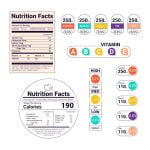Contents
Introduction
Sour cream is a versatile dairy product loved for its rich, tangy flavor and creamy texture. It’s a popular condiment for various dishes, from baked potatoes to tacos and even as a base for creamy salad dressings. While traditional sour cream is delicious, it can be high in saturated fats and calories. However, low-fat sour cream offers a healthier alternative without sacrificing taste. In this article, we’ll dive into the nutrition of low-fat sour cream, exploring its benefits and how it can be a smart choice for those looking to reduce their fat intake.

What is Low-Fat Sour Cream?
Low-fat sour cream is a modified version of traditional sour cream, made by reducing the fat content while retaining the tangy taste and creamy texture. It is created through the same fermentation process as regular sour cream, using lactic acid bacteria to thicken and sour the cream. The primary difference is the lower fat content, which makes it a more health-conscious option.
Nutritional Profile
Here’s a breakdown of the typical nutritional profile for a 2-tablespoon (30-gram) serving of low-fat sour cream:
- Calories: Low-fat sour cream contains approximately 20-30 calories per serving, making it a calorie-friendly choice.
- Fat: Unlike regular sour cream, which can have up to 5 grams of fat per serving, low-fat sour cream typically contains only 1-2 grams of fat. This reduction in fat content is particularly beneficial for those watching their saturated fat intake.
- Protein: A 2-tablespoon serving typically provides about 1-2 grams of protein, which can be a minor contribution to your daily protein needs.
- Carbohydrates: Low-fat sour cream contains around 1-2 grams of carbohydrates per serving, making it a low-carb option.
- Calcium: Dairy products like sour cream are good sources of calcium. Low-fat sour cream provides approximately 20-30 milligrams of calcium per serving, contributing to your daily calcium intake.
Benefits of Low-Fat Sour Cream
- Lower in Saturated Fat: One of the main advantages of choosing low-fat sour cream is its reduced saturated fat content. High intake of saturated fat is linked to an increased risk of heart disease, so opting for the low-fat version can be a heart-healthy choice.
- Fewer Calories: If you’re watching your calorie intake, low-fat sour cream is a smart choice as it contains fewer calories compared to regular sour cream.
- Maintains Flavor: Despite the reduced fat content, low-fat sour cream maintains the tangy and creamy flavor that people love. It can be used as a healthier substitute in recipes without compromising taste.
- Weight Management: Incorporating low-fat sour cream into your diet can be helpful for weight management, as it offers the rich flavor of sour cream with fewer calories and less fat.
- Calcium Source: Low-fat sour cream is a source of calcium, which is essential for strong bones and teeth. Incorporating it into your diet can contribute to your daily calcium needs.
How to Use Low-Fat Sour Cream
Low-fat sour cream can be used in various ways:
- Toppings: Use it as a topping for baked potatoes, tacos, nachos, and chili.
- Dips: Create creamy and flavorful dips for vegetables or chips by blending low-fat sour cream with herbs and spices.
- Salad Dressing: Make a healthier salad dressing by mixing low-fat sour cream with herbs, lemon juice, and a touch of olive oil.
- Baking: Substitute low-fat sour cream for regular sour cream in baking recipes for a lighter option in cakes, muffins, and scones.
- Marinades: Incorporate it into marinades for meats, poultry, or fish to add flavor and moisture.
Conclusion
Low-fat sour cream is a nutritious and versatile dairy product that allows you to enjoy the creamy, tangy goodness of traditional sour cream with fewer calories and less saturated fat. By making this simple swap, you can create healthier meals without sacrificing flavor. Whether you’re looking to reduce your saturated fat intake, manage your weight, or simply enjoy a lighter version of your favorite dishes, low-fat sour cream is a valuable addition to your kitchen.



